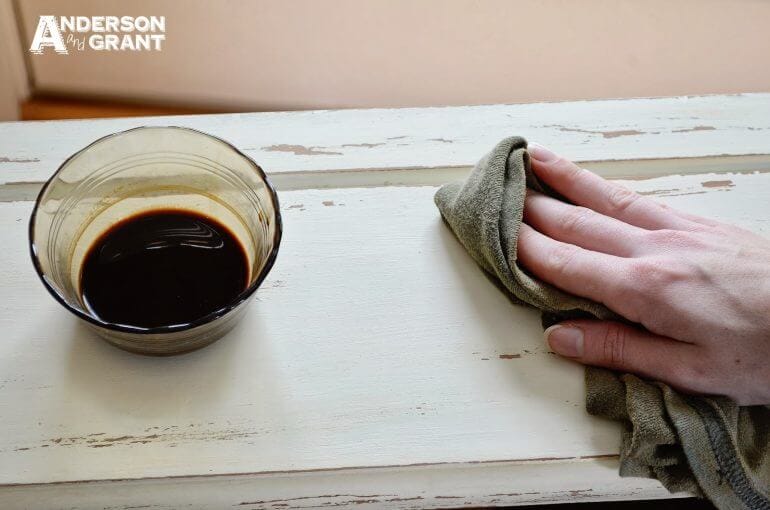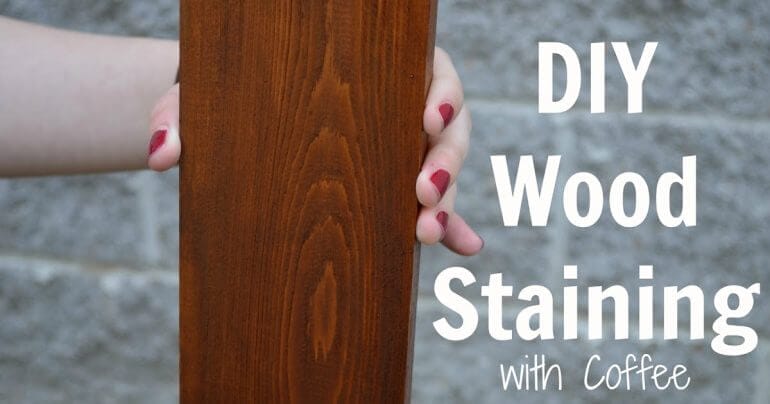Yes, you can stain wood with coffee! Coffee can be used as a natural and eco-friendly alternative to traditional wood stains. Due to its natural tannins, coffee can create a rich, warm color on wood surfaces. Additionally, staining wood with coffee can give it a unique and rustic appearance, perfect for DIY projects or restoring old furniture. In this article, we will explore the process of staining wood with coffee and share some tips and tricks to achieve the desired results.

Benefits of Staining Wood with Coffee
Staining wood is a popular technique used to enhance the appearance and durability of wooden surfaces. While there are various types of stains available in the market, one unique and eco-friendly option is staining wood with coffee. This unconventional method offers several benefits that make it a popular choice among DIY enthusiasts and environmentally conscious individuals. In this section, we will explore the advantages of using coffee as a wood stain.

1. Natural and Non-toxic
One of the major advantages of using coffee as a wood stain is its natural and non-toxic properties. Unlike commercial wood stains that often contain harmful chemicals, coffee is a safe and eco-friendly alternative. It does not release any toxic fumes and is therefore safe to use indoors without the need for special ventilation.
2. Cost-effective
Another benefit of staining wood with coffee is its cost-effectiveness. Coffee grounds or brewed coffee are readily available and inexpensive compared to traditional wood stains. This makes it an affordable option for those on a tight budget or looking to save money on their DIY projects.
3. Unique and Warm Tone
Wood stained with coffee offers a unique and warm tone that adds character and depth to the wood. The natural brown color of coffee creates a rustic and vintage look that complements various interior styles, from farmhouse to bohemian. It gives the wood a rich, earthy hue that enhances its natural beauty.
4. Versatile Application
Coffee stain can be applied to a wide range of wood surfaces, including furniture, flooring, cabinets, and even outdoor structures like decks and fences. Its versatile nature allows you to experiment with different wood types and create a custom look that suits your personal style.
5. Easy Application and Maintenance
Staining wood with coffee is a straightforward process that requires minimal tools and expertise. Simply brew a strong cup of coffee or mix coffee grounds with water, then apply the solution to the wood with a brush or cloth. Allow it to dry, and if desired, apply multiple coats for a darker shade. The surface can be sealed with a clear varnish or wax for added protection and longevity.
In terms of maintenance, coffee-stained wood is relatively easy to care for. Regular cleaning with a mild detergent and soft cloth is usually sufficient to maintain its appearance. If any scratches or imperfections occur over time, they can be easily touched up with additional coffee stain.
6. Eco-friendly and Sustainable
Using coffee as a wood stain aligns with sustainable and eco-friendly practices. By repurposing coffee grounds or utilizing brewed coffee, you can reduce waste and contribute to a greener environment. Additionally, coffee stains do not harm plants or animals, making it a safe option for outdoor applications.
Overall, staining wood with coffee offers a range of benefits that make it an attractive choice for DIY enthusiasts and environmentally conscious individuals. Its natural and non-toxic properties, cost-effectiveness, unique tone, versatile application, easy maintenance, and eco-friendly nature make it a standout alternative to traditional wood stains. So next time you embark on a woodworking project, consider reaching for a cup of coffee to enhance the beauty of your wood surfaces.

Step-by-Step Guide to Staining Wood with Coffee
If you’re looking to give your wooden furniture or crafts a rustic, aged look, staining with coffee can be a great option. Not only is it an eco-friendly alternative to traditional wood stains, but it also adds a unique and charming character to your wood pieces. In this section, we will provide you with a step-by-step guide on how to stain wood with coffee.
Materials Needed:
- Unfinished wood piece
- Ground coffee
- Hot water
- Bowl or container
- Paintbrush or sponge
- Sandpaper
- Wood sealant or wax (optional)
Step 1: Prepare the Wood
Start by preparing the wood surface. If your wood piece is already finished, you will need to sand it down to remove any existing stain or varnish. Use sandpaper to create a smooth and even surface for better absorption of the coffee stain.
Step 2: Brew the Coffee
In a container or bowl, brew a strong cup of coffee using ground coffee and hot water. The coffee should be concentrated to achieve a darker stain. Let the coffee cool down to room temperature.
Step 3: Apply the Coffee Stain
Using a paintbrush or sponge, apply the brewed coffee onto the wood surface. Start with a small amount and gradually build up the color intensity as desired. Make sure to cover the entire surface evenly for consistent staining.
Step 4: Allow the Stain to Dry
After applying the coffee stain, allow it to dry completely. This may take a few hours or overnight depending on the temperature and humidity. Avoid touching or disturbing the stained wood during the drying process.
Step 5: Assess the Color
Once the stain is dry, assess the color of the wood. If you desire a darker shade, you can apply additional coats of coffee stain following the same process. Remember to let each coat dry before applying the next one.
Step 6: Seal the Wood (Optional)
If you want to protect the stained wood and enhance its longevity, you can apply a wood sealant or wax. This step is optional but recommended, especially for wood items that will be exposed to moisture or frequent use.
Step 7: Enjoy Your Stained Wood
Once the sealant or wax has dried, your stained wood is ready to be enjoyed. Whether it’s a vintage-looking coffee table or a decorative wooden sign, the unique charm of the coffee stain will add warmth and character to your space.
In summary, staining wood with coffee is a simple and cost-effective way to achieve a rustic and aged look. By following this step-by-step guide, you can transform your plain wood pieces into beautiful, one-of-a-kind creations. Experiment with different coffee concentrations and application techniques to achieve the desired color and effect. Happy staining!

Tips and Tricks for Achieving the Perfect Coffee Stained Wood
If you’re looking to add a rustic and unique touch to your woodworking projects, using a coffee stain can be a great option. Coffee stained wood offers a warm and natural look that is perfect for creating a vintage or weathered effect. In this section, we will share some useful tips and tricks to help you achieve the perfect coffee stained wood finish.
1. Choose the Right Type of Wood
The type of wood you use can greatly affect the outcome of your coffee stain. Lighter woods tend to absorb the stain more readily, while darker woods may require multiple coats to achieve the desired color. It’s important to experiment on a small test piece of wood to determine how the coffee stain will appear on your chosen wood type.
2. Brew Strong Coffee
The strength of your coffee will determine the richness of the stain. To achieve a darker and more intense color, brew a strong pot of coffee using a dark roast or espresso beans. Avoid using flavored or sweetened coffee, as this can affect the final color and may leave behind unwanted residue.
3. Prepare the Wood Surface
Before applying the coffee stain, it’s crucial to prepare the wood surface properly. Start by sanding the wood to remove any existing finish or rough spots. This will ensure that the stain is absorbed evenly. Wipe away any dust or debris with a damp cloth before proceeding.
4. Apply the Coffee Stain
There are several methods you can use to apply the coffee stain to the wood. One common approach is to use a brush or sponge to evenly spread the stain over the surface. Be sure to work in the direction of the wood grain for a more natural appearance. Alternatively, you can also dip the wood into a container of coffee and allow it to soak for a few minutes before removing and drying.
5. Experiment with Different Techniques
Don’t be afraid to get creative with your coffee staining technique. You can try diluting the coffee with water to achieve a lighter color, or even mix in other natural ingredients like vinegar or steel wool for a weathered effect. Additionally, you can experiment with different application methods such as using fabric or a spray bottle to create unique patterns and textures.
6. Allow Sufficient Drying Time
After applying the coffee stain, allow the wood to dry completely before sealing or applying any additional finishes. This will ensure that the stain sets properly and prevents any smudging or bleeding of the color. The drying time can vary depending on the temperature and humidity, so be patient and give it ample time.
7. Seal and Protect the Stained Wood
To preserve the beauty and longevity of your coffee stained wood, it’s recommended to seal it with an appropriate finish. You can choose from a variety of options such as polyurethane, wax, or oil-based sealants. Apply the chosen finish according to the manufacturer’s instructions and allow it to dry completely before using or displaying your finished piece.
In summary, achieving the perfect coffee stained wood requires careful selection of wood type, brewing strong coffee, proper wood surface preparation, experimenting with different techniques, allowing sufficient drying time, and sealing the stained wood. By following these tips and tricks, you can create stunning and unique wooden pieces with a beautiful coffee stained finish.
Exploring Creative Coffee Stain Techniques for Wood
Wood is a versatile material that can be transformed into various beautiful pieces of furniture, decor, and artwork. If you are a DIY enthusiast or a professional woodworker, you might be familiar with different techniques to enhance the appearance of wood. One unique and creative technique that has gained popularity in recent years is using coffee stains to add a rustic and aged look to wood.
1. Preparing the Wood
Before you start staining the wood with coffee, it is essential to prepare the surface properly. Start by sanding the wood to remove any roughness or imperfections. This step will ensure that the coffee stain adheres well and gives a smooth finish. Use a fine-grit sandpaper for this purpose.
Once the wood is sanded, wipe off any dust or residual particles using a tack cloth or a soft cloth. This step is crucial as it helps in achieving an even and consistent stain on the wood.
2. Choosing the Right Coffee
When it comes to coffee staining, the type of coffee you use plays a significant role in the final outcome. Different types of coffee, such as instant coffee, ground coffee, or brewed coffee, can produce varying shades and tones on the wood.
Experiment with different types of coffee to achieve the desired effect. Stronger coffee preparations, like espresso or dark roast, tend to create deeper and darker stains, while lighter coffee varieties result in a more subtle and lighter stain.
3. Brewing the Coffee
To create a coffee stain, you need to brew a concentrated solution. Start by boiling water, and then add the desired amount of coffee grounds or instant coffee. Allow the coffee to steep for at least 15 minutes to ensure a rich and dark pigment.
Once the coffee is brewed, strain out the coffee grounds or use a fine-mesh sieve to remove any particles. Let the coffee cool down completely before applying it to the wood.
4. Applying the Coffee Stain
Now comes the fun part – applying the coffee stain to the wood. There are various methods you can use to achieve different effects:
- Brushing Method: Dip a brush into the brewed coffee and apply it evenly onto the wood surface. This method is suitable for larger areas and allows for better control over the intensity of the stain.
- Dripping Method: Fill a small container with the brewed coffee and let it drip onto the wood surface. This technique creates unique patterns and gives a more organic and random look.
- Sponge Method: Dip a sponge in the coffee solution and gently dab it onto the wood surface. This method is ideal for achieving a weathered or aged appearance.
Remember to work in small sections and blend the stain evenly to avoid any visible lines or streaks. If you want a darker shade, apply multiple coats, allowing each layer to dry completely before proceeding.
5. Sealing the Stained Wood
Once you are satisfied with the coffee stain, it is crucial to protect the wood by applying a sealant. A sealant helps to preserve the stain, prevent fading, and enhance the durability of the wood.
Choose a clear sealant, such as polyurethane or varnish, and apply it evenly over the stained wood using a brush or a cloth. Follow the manufacturer’s instructions for drying and curing time.
6. Enhancing the Coffee Stain
If you want to take your coffee-stained wood to the next level, you can experiment with additional techniques and materials:
- Distressing: Use sandpaper or a wire brush to distress the wood surface lightly. This technique adds more character and highlights the coffee stain.
- Stenciling: Apply a stencil design on the stained wood and use a different shade of coffee to create patterns or artwork.
- Antiquing: Apply a dark glaze or stain over the coffee stain to create an antique or vintage look.
Feel free to explore various combinations and techniques to achieve unique and customized results.
Summary
Exploring creative coffee stain techniques for wood adds a touch of uniqueness and character to your woodworking projects. By following the steps mentioned above, you can achieve stunning results and create beautiful pieces with a rustic and aged appearance. Remember to experiment with
FAQs
Can you stain wood with coffee?
Yes, you can stain wood with coffee. Brew a strong pot of coffee, let it cool, and then brush it onto the wood surface using a paintbrush. Repeat this process until you achieve the desired shade. Finally, seal the stained wood with a clear protective finish.
Conclusion
In conclusion, staining wood with coffee is a fascinating and eco-friendly alternative to traditional wood stains. The natural pigments in coffee can create unique and earthy tones, giving a rustic and organic look to your wooden surfaces. Whether you’re upcycling furniture or adding character to your home decor, coffee stains can offer a cost-effective and sustainable solution. However, it’s important to note that coffee stains may not provide the same level of durability and protection as commercial stains. Regular maintenance and sealing are recommended to preserve the longevity of the coffee-stained wood. So, why not give coffee staining a try and bring a touch of warmth and character to your next woodworking project?
